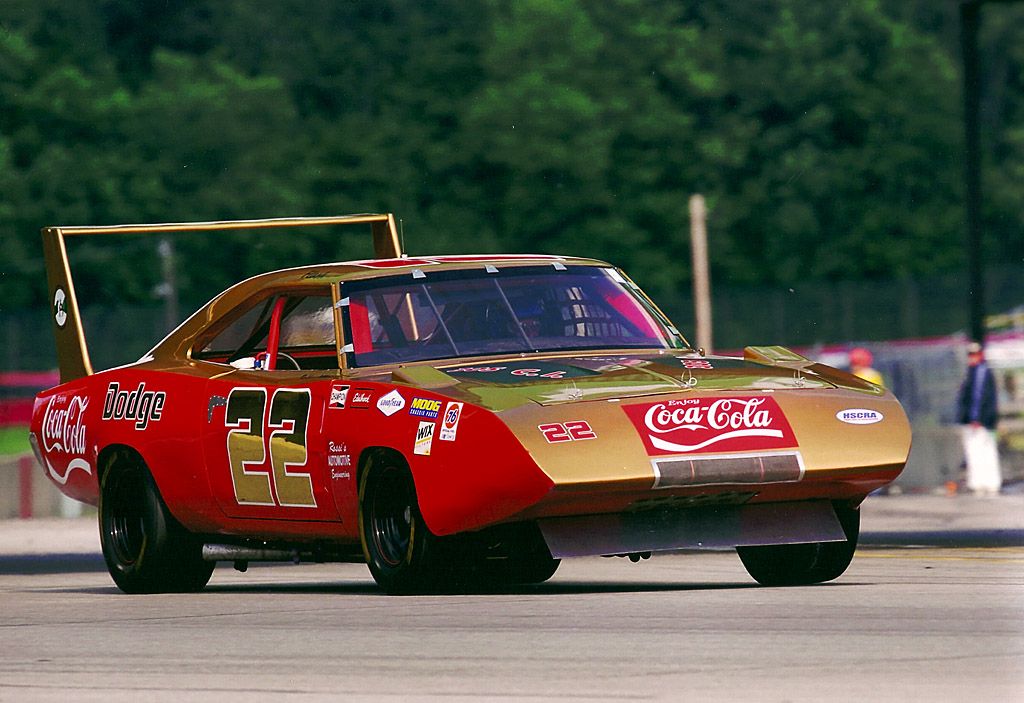Last year towards the end of the NASCAR season we had the opportunity to talk with three time Daytona 500 winner and South Florida native Bobby Allison about his life in the stock car circuit. One of his more memorable machines was a red and gold Coca-cola sponsored 1970 Dodge Charger->ke218 Daytona, that oddly enough never even turned a wheel in competition, recently went up for auction at the 2010 Mecum Auto Auctions in Kissimmee, FL.
What makes this car so special, aside from the over sized wing towering over the rear end that was designed to provide down force and stability at over 200 MPH on the high banks of super speedways like Talladega and the track the car was named after, Daytona. For the 1970 season, the man in charge of NASCAR, Bill France, handicapped the big winged race cars by limiting their displacement forcing racers to choose between sheer power and aerodynamic optimization. Never being one to back down from a challenge, Allison and car builder Mario Rossi decided to try their luck with a destroked version of the 426 Hemi that only displaced 305 cubic inches.
Any enthusiast knows that there is no replacement for displacement, but any engine builder will tell you that for every 0.1 Liters you lose, the motor gains about 2,000 RPM. While the new combination looked promising for the 1970 NASCAR season, Mr. France flexed his muscle once again and banned the car from competition, so the world was never able to see what a big winged high revving Hemi could have done on track. Unfortunately the one of a kind test mule didn't sell at auction despite registering a high bid of $210,000.
Press release after the jump.
PRESS RELEASE
By 1968, the advantage previously enjoyed by Chrysler’s Hemi in NASCAR had been virtually eclipsed by its competitors. Ford had answered the more aerodynamic Charger 500 with its own slippery versions of the Torino and Mercury Cyclone, so Dodge pulled out all the stops and unleashed the wild, winged Daytona. With its pointed front nose and high rear wing, the Daytona put Mopar back at the front of the grid, and the Aero Wars were under way.
After almost two years of domination by just two manufacturers, NASCAR founder and President Bill France let it be known that the winged cars would be subjected to severe displacement limitations, and most car owners immediately abandoned them, with one significant holdout: a young rebel named Mario Rossi.
Rossi and his driver Bobby Allison had invested much time and treasure in their Number 22 Daytona, and so decided to experiment with a destroked 305 cubic inch small block. Allison tested the new combination at Daytona and Talladega but never drove it in competition.
Recently the car was visually inspected by Bobby Allison and certified as the test car used in the 1970 NASCAR season. The Certificate of Authenticity, which is signed by Allison and accompanies the car, reads:
This car was built and raced by Mario Rossi. This car was driven by Bobby Allison during testing at Daytona and Talladega in preparation for the upcoming 1970 NASCAR season. Because of the NASCAR rule change from the 426 Hemi engine to the 305 CI displacement limit this car was not raced.
The only test car known to still exist, it has gone through a ground-up restoration and subsequently been driven by “Flash” Gordon Sprague in 10 historic stock car events, winning all 10 races.

